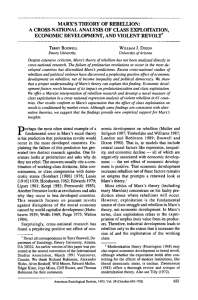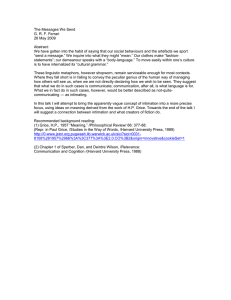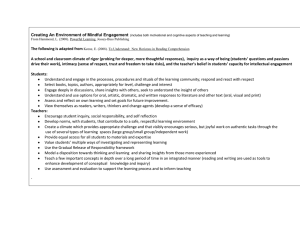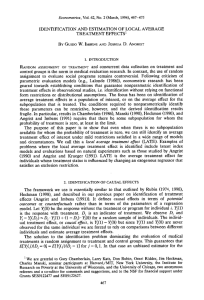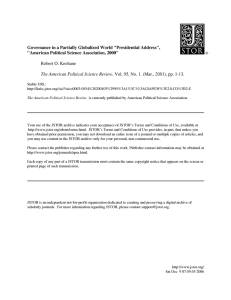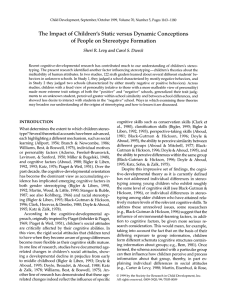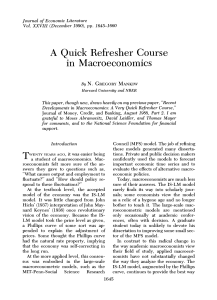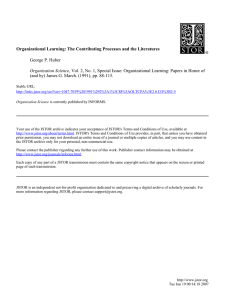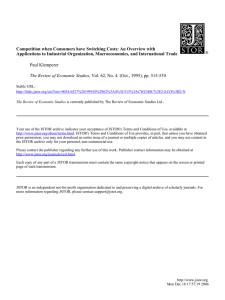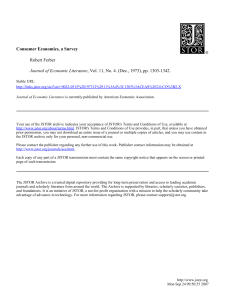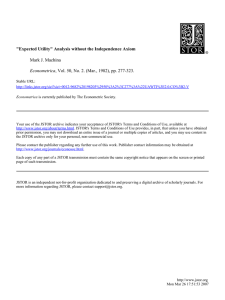Philosophy of Leadership in Education
advertisement
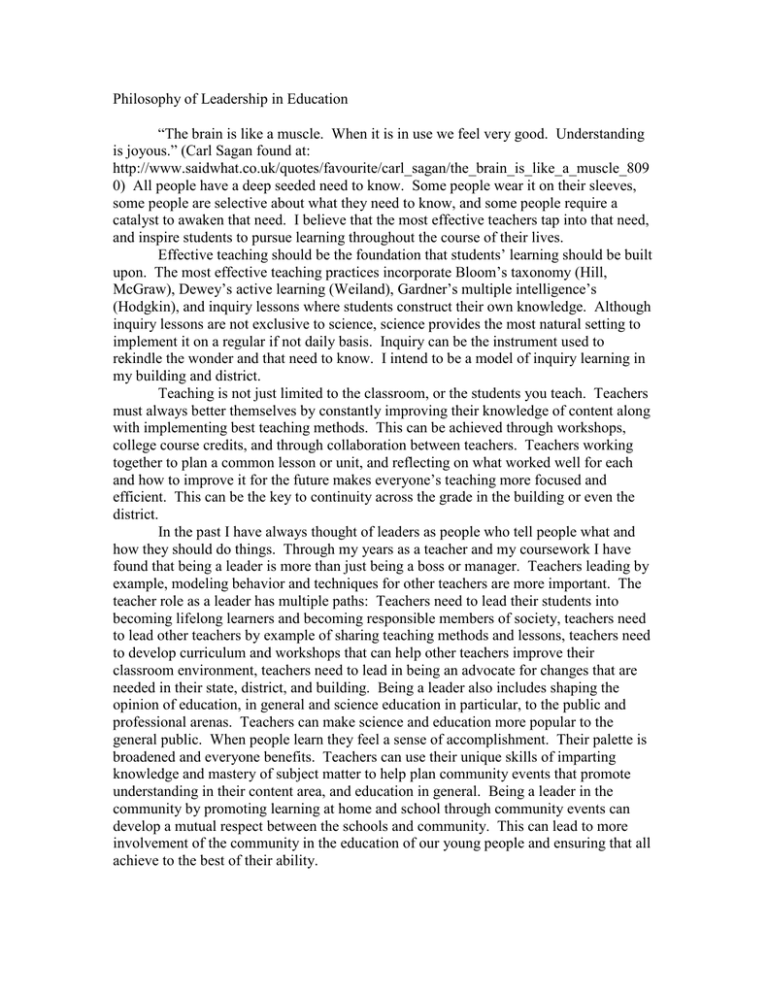
Philosophy of Leadership in Education “The brain is like a muscle. When it is in use we feel very good. Understanding is joyous.” (Carl Sagan found at: http://www.saidwhat.co.uk/quotes/favourite/carl_sagan/the_brain_is_like_a_muscle_809 0) All people have a deep seeded need to know. Some people wear it on their sleeves, some people are selective about what they need to know, and some people require a catalyst to awaken that need. I believe that the most effective teachers tap into that need, and inspire students to pursue learning throughout the course of their lives. Effective teaching should be the foundation that students’ learning should be built upon. The most effective teaching practices incorporate Bloom’s taxonomy (Hill, McGraw), Dewey’s active learning (Weiland), Gardner’s multiple intelligence’s (Hodgkin), and inquiry lessons where students construct their own knowledge. Although inquiry lessons are not exclusive to science, science provides the most natural setting to implement it on a regular if not daily basis. Inquiry can be the instrument used to rekindle the wonder and that need to know. I intend to be a model of inquiry learning in my building and district. Teaching is not just limited to the classroom, or the students you teach. Teachers must always better themselves by constantly improving their knowledge of content along with implementing best teaching methods. This can be achieved through workshops, college course credits, and through collaboration between teachers. Teachers working together to plan a common lesson or unit, and reflecting on what worked well for each and how to improve it for the future makes everyone’s teaching more focused and efficient. This can be the key to continuity across the grade in the building or even the district. In the past I have always thought of leaders as people who tell people what and how they should do things. Through my years as a teacher and my coursework I have found that being a leader is more than just being a boss or manager. Teachers leading by example, modeling behavior and techniques for other teachers are more important. The teacher role as a leader has multiple paths: Teachers need to lead their students into becoming lifelong learners and becoming responsible members of society, teachers need to lead other teachers by example of sharing teaching methods and lessons, teachers need to develop curriculum and workshops that can help other teachers improve their classroom environment, teachers need to lead in being an advocate for changes that are needed in their state, district, and building. Being a leader also includes shaping the opinion of education, in general and science education in particular, to the public and professional arenas. Teachers can make science and education more popular to the general public. When people learn they feel a sense of accomplishment. Their palette is broadened and everyone benefits. Teachers can use their unique skills of imparting knowledge and mastery of subject matter to help plan community events that promote understanding in their content area, and education in general. Being a leader in the community by promoting learning at home and school through community events can develop a mutual respect between the schools and community. This can lead to more involvement of the community in the education of our young people and ensuring that all achieve to the best of their ability. Being a leader is to be a tool for positive change in all areas of your profession. From teaching strategies and best practices, to guiding curriculum, to doing professional development, making learning accessible for all, and promoting a bridge between the community and the school. Citations: 1. Testing the Simplex Assumption Underlying Bloom's 'Taxonomy' P. W. Hill; B. McGaw American Educational Research Journal, Vol. 18, No. 1. (Spring, 1981), pp. 93101. Stable URL: http://links.jstor.org/sici?sici=00028312%28198121%2918%3A1%3C93%3ATTSAUB%3E2.0.CO%3B2-W Abstract: In an attempt to resolve conflicting conclusions arising from previous analyses, the LISREL method of Jöreskog was applied to the data of Kropp and Stoker. It was found that the simplex assumption underlying Bloom's taxonomy is supported when the knowledge category is deleted from the taxonomy. 2. Emerson, Experience, and Experiential Learning Steven Weiland Peabody Journal of Education, Vol. 58, No. 3, Issues and Trends in American Education. (Apr., 1981), pp. 161-167. Stable URL: http://links.jstor.org/sici?sici=0161956X%28198104%2958%3A3%3C161%3AEEAEL%3E2.0.CO%3B2-T 3. Michael Polanyi on the Activity of Knowing: The Bearing of His Ideas on the Theory of Multiple Intelligences Robin A. Hodgkin Oxford Review of Education, Vol. 18, No. 3. (1992), pp. 253-267. Stable URL: http://links.jstor.org/sici?sici=03054985%281992%2918%3A3%3C253%3AMPOTAO%3E2.0.CO%3B2-W Abstract: Michael Polyani's philosophy of science and his corresponding ideas about how we act, perceive and know was, in part, a revolt against materialist reductionism. In its place he offered a 'holistic' theory (not his phrase) of personal knowing: we build up small skills and percepts into larger wholes--Gestalts. Polanyi showed that such 'personal knowledge' did not have to be subjective and arbitrary because its components and unifying patterns could reflect real patterns in the universe. Polanyi's account of how two eyes present differing versions of the world is instructive. It can now be used as a model for understanding how the two parts of someone's brain may integrate two versions of the world into one synthetic consciousness. Howard Gardner's and the author's versions of 'the multiple intelligences' theory of how we learn and also the Sperry-Gazzaniga picture of how two brain hemispheres cooperate actively in making sense of the world are surveyed under this Polanyian rubric. These writers highlight both the necessity of active learning and the disciplining, articulating importance of linguistic skills in giving coherence to any multiple intelligence version of how a person acquires and expresses overall competence. Refuting articles 1. Writing as Inquiry: Some Questions for Teachers Janice M. Lauer College Composition and Communication, Vol. 33, No. 1. (Feb., 1982), pp. 8993. Stable URL: http://links.jstor.org/sici?sici=0010096X%28198202%2933%3A1%3C89%3AWAISQF%3E2.0.CO%3B2-D 2. Student Inquiry in a Physics Class Discussion David Hammer Cognition and Instruction, Vol. 13, No. 3. (1995), pp. 401-430. Stable URL: http://links.jstor.org/sici?sici=07370008%281995%2913%3A3%3C401%3ASIIAPC%3E2.0.CO%3B2-F Abstract: There is a long, rich history of arguments for the importance of involving students in a process of inquiry. For many instructors, however, promoting student inquiry is a difficult agenda to pursue for two reasons. First, there is often tension for instructors between concerns for this agenda and more traditional concerns for the correctness and completeness of students' understanding. Second, it is not easy to recognize when productive student inquiry is taking place. For a teacher in class, what is valuable about the students' participation at any given moment may-not be as obvious as what is flawed and ambiguous in their arguments. For this article, I analyze a short excerpt from a high school physics class discussion to consider the value of the students' work as inquiry and to illustrate a teacher's negotiation of the tension between inquiry and traditional content-oriented concerns. In this way, I try to discover the beginnings of science in what the students say and do, rather than to apply criteria from a particular model of scientific reasoning. This exploration for students' knowledge and abilities is offered both as an approach to research on student inquiry and as a mode of instructional practice to support that inquiry.
